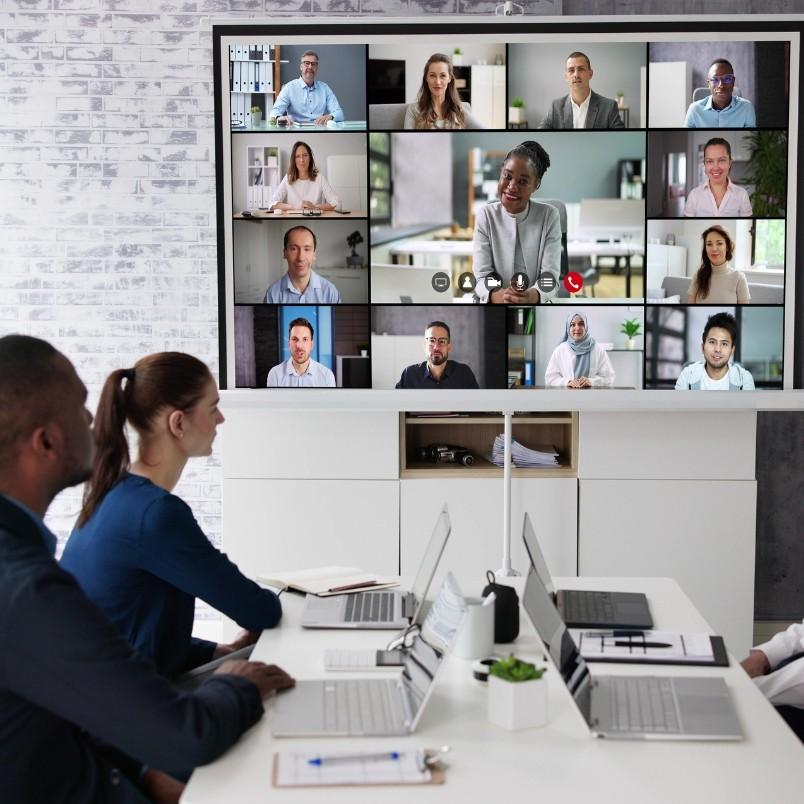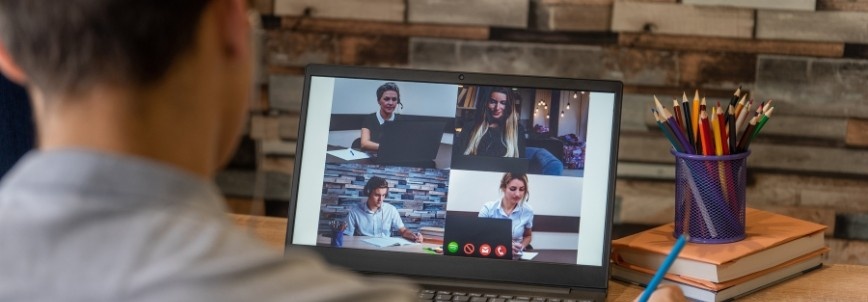Agile Series Episode 2: Agile Team Collaboration in a Hybrid Work Model
By: Hajime Estanislao, PMP®; Editor: Geram Lompon; Reviewed by: Alvin Villanueva, PMP®
Does your team feel connected when some are in the office, others are remote, and everyone is in various time zones?
Hybrid work has changed how Agile teams operate. Ceremonies like sprint planning, daily scrum, and retrospectives have not disappeared but have shifted to digital spaces. However, with flexible schedules, fewer face-to-face conversations, and tailor-fit tools, even well-established teams become out of sync. In traditional team settings, face-to-face interactions promote connections and team cohesion. Elements that can be harder to maintain in hybrid or remote environments.
You do not need to choose between agility and flexibility. With structure, habits, and communication practices, hybrid teams can collaborate just as effectively as fully co-located teams. Whether coordinating deliverables across multiple countries or syncing in a part-time office schedule, collaboration can thrive. However, unlike traditional teams that benefit from a central location as a core hub for activities, hybrid models often rely on digital hubs to coordinate work and share resources.
In this episode, we will explore how Agile teams can work in a hybrid environment, using updated practices and modern technologies to maintain focus, connection, and momentum.

What is a Hybrid Work Model?
A hybrid work model allows team members to divide their time between working remotely and being present in a shared physical space. The office environment is the traditional setting for in-person collaboration, promoting team morale, spontaneous interactions, and a strong workplace culture. It offers the flexibility to perform tasks where they make the most sense without removing the opportunity for in-person collaboration when needed.
This structure has become a standard in many Agile and software development environments. It enables teams to tap into global talent, improve work-life balance, and adapt quickly. It also introduces new challenges such as communication gaps, coordination across time zones, and maintaining team identity. Agile frameworks help address these challenges by encouraging visibility, structure, and continuous improvement.
Benefits of Hybrid Teams
Hybrid teams bring together the best of two worlds – combining the flexibility of remote work with the energy and creativity of in-person collaboration. This model empowers teams to design their workdays for maximum productivity and work-life balance, allowing team members to focus deeply when working remotely and come together for high-impact collaboration when needed.
One benefit of hybrid teams is the ability to tap into a broader talent pool, as location is no longer a barrier. It means companies can attract and retain top talent from anywhere, building diverse teams with a wide range of perspectives. Hybrid teams also help reduce costs related to commuting and office space, making operations more efficient and environmentally friendly.
With the right collaboration tools and communication practices, hybrid teams can maintain strong connections and deliver high-quality results. The flexibility of remote work supports employee satisfaction, while in-person interactions spark creativity and strengthen relationships. Ultimately, hybrid teams are well-positioned to adapt quickly, innovate, and thrive.

How Can Agile Teams Collaborate in a Hybrid Work Model?
Agile teams succeed in hybrid setups when they rely on intentional collaboration, regular check-ins, and defined expectations. Remote and hybrid teams face challenges and opportunities that require adapting agile practices for effective communication and alignment. Here are three practical examples of how hybrid teams can adjust Agile practices.
Asynchronous Sprint Planning with Digital Boards
Teams working across different hours can prepare sprint plans collaboratively by using a digital tool and contributing to shared platforms like Jira, Trello, or ClickUp. These platforms also serve as asynchronous communication tools before a final live review. The shared platform acts as a central location for team collaboration, making relevant information easily accessible. Estimates, comments, and dependencies are noted in advance, allowing for shorter planning meetings that focus on final alignment rather than ground-up discussion.

Flexible Daily Check-ins
Rather than relying solely on traditional agile practices such as stand-ups, teams can log daily updates through chat threads or short videos. It keeps everyone informed without forcing a rigid schedule and works well for distributed teams.
The classic stand-up meeting has evolved in hybrid teams, with asynchronous updates replacing or supplementing live check-ins to maintain effective communication. This approach ensures that team members stay aligned and can address issues promptly, regardless of time zone or location.
Inclusive Online Retrospectives
Digital retrospective tools like Miro allow team members to contribute feedback regardless of location or time zone, making the sprint retrospective accessible. Anonymous input and structured templates make it easier to reflect honestly and agree on follow-up routines while also creating a safe space for open communication.
Encourage each team member to share challenges faced during the sprint, promoting transparency and problem-solving. Reviewing action items and outcomes during the next retrospective helps ensure continuous improvement and accountability.
These approaches preserve the Agile spirit of openness, learning, and responsiveness even when the team is rarely in the same physical space.

Hybrid Team Dynamics: Building Trust and Cohesion Across Locations
Building trust and cohesion in a hybrid team requires intentional effort when team members are in different locations. Open communication is the foundation; regular video conferencing meetings, transparent updates, and accessible chat channels help everyone stay on the same page, regardless of work location.
To build a sense of belonging, hybrid teams can create opportunities for informal connection: virtual coffee breaks or online team-building activities. These moments help team members get to know each other beyond work tasks, strengthening personal connections and boosting morale.
Setting clear expectations around goals, workflows, and communication norms is relevant for hybrid teams. When everyone understands how and when to share updates, ask questions, or escalate issues, collaboration becomes smoother and more effective. Recognition of individual achievements and celebration of team milestones, whether during meetings or through digital shout-outs, also helps motivate and unify the team.

How Can Generative AI Help Collaboration for Hybrid Teams?
While tools do not replace teamwork, they enable it across distance and time, making it easier for a remote team to collaborate effectively.
For example, communication apps like Slack, Zoom, and Microsoft Teams help teams stay connected and share information in real-time.
What’s Useful Now:
- Project platforms organize work in shared spaces that stay current and visible.
- Communication apps, including asynchronous tools like Slack, Microsoft Teams, and email, ensure teams choose when and how to respond, making them essential for hybrid teams.
- Documentation tools reduce repetition and keep shared knowledge updated.
Rather than relying on constant meetings or one-size-fits-all tools, teams benefit from the technology that fits their pace, task flow, and team habits.

Reasons Why Collaboration in a Hybrid Work Model is Easy
At first glance, collaborating across locations might seem like a logistical hurdle. But in practice, many Agile practices were designed with adaptability in mind, even in remote environments. When paired with deliberate communication and a few simple tools, hybrid work becomes possible, more inclusive, and efficient.
Here’s why collaboration in a hybrid model works:
- Agile meetings become virtual and asynchronous formats.
- Digital boards make task status and priorities easy to follow.
- Messaging platforms allow for quick check-ins and thoughtful responses.
- Teams can align without needing everyone to be online, establishing a shared understanding of goals and priorities.
- Shared dashboards monitor project health at a glance.
- Regular feedback loops keep progress visible and expectations clear.
- Greater autonomy gives team members flexibility to manage their schedules, leading to deeper ownership and more sustainable output.
- Technology helps include voices that might get lost in in-person meetings.
- Trust builds as team members work together, communicate regularly, and participate in team bonding activities.
- A balanced model supports both delivery and well-being.
- To-do lists can be aligned with overall project and sprint goals, ensuring individual efforts contribute to broader success.

Step-by-Step Instructions for Integrating the Latest Technologies
You do not need to overhaul your system to benefit from modern technology; refine the way your team already works and reduce time spent on manual, repetitive tasks. The following steps combine Agile thinking with tools such as robotic process automation (RPA), intelligent documentation assistants, and collaborative project platforms that serve as a central location for the development team to coordinate activities, facilitate meetings, and enable the Scrum Master or project manager to guide the team through structured events.
Spot the Repeats: Identify Repetitive Workflows
Begin by checking repetitive work: weekly updates, duplicated entries, or simple status reports.
- Make a list of tasks that take time but add little insight.
- Highlight those that interrupt the flow or require switching between tools.
- Match these tasks with simple automation options such as Slack reminders, form triggers, or bot updates.
- This step frees up time for creative and strategic work.

Select Smart Tools: Choose Technology That Matches Your Workflow
Use tools that align with how your team already works; do not force adoption just because they are new and available.
- For planning and sprint tracks, tools like Jira, Asana, or ClickUp work wonders.
- For conversations, integrate Slack, Microsoft Teams, or the existing tool the team already uses. Microsoft Teams enables real-time instant messaging, video conferencing, and file sharing, and integrates seamlessly with other productivity tools, such as Microsoft 365.
- For document sharing and knowledge base, use Confluence, Notion, or shared drives with a clear structure.
Start small. One well-integrated tool is better than four disconnected ones.
Introduce Generative AI: Focus on Value, Not Novelty
Text generation tools can help lighten the load, but they should support clarity and not lead decisions.
- Use it to summarize long meetings or convert bullet points into user stories.
- Draft agendas or release notes that the team can then review and edit.
- Capture feedback themes across retrospectives to make patterns easier to spot.
- Keep human review in the loop and focus these tools on time-saving, not judgment.

Automate Routine Workflows: Use RPA to Eliminate Drag
Robotic Process Automation can streamline behind-the-scenes tasks such as system updates or progress reporting.
- Set up bots to automatically pull ticket data into reports or dashboards.
- Automate recurring communications from sprint start reminders to feedback forms.
- Link intake forms directly to backlog entries to avoid manual entry.
These shifts help teams focus on solving problems and not just documenting them.
Pilot, Adjust, and Expand: Improve Gradually
Tech only adds value when the team uses it effectively. Start with one or two changes and improve from there.
- Pilot one workflow before scaling widely.
- Collect input during retrospectives or informal chats.
- Adjust expectations based on feedback, not tool features.
- Experiment, but ensure each change supports the way your team works.
![]()
Measuring Progress: Tracking Success in a Hybrid Agile Team
For hybrid agile teams, measuring progress is about more than just tracking tasks but ensuring alignment, transparency, and continuous improvement. Regular sprint planning sessions and retrospectives provide structured opportunities to set sprint goals, review outcomes, and identify areas for growth.
Digital tools play a role in helping teams track project progress in real-time.
Key performance indicators (KPIs) such as story points completed, sprint goals achieved, and customer satisfaction scores help agile teams measure their impact and adjust strategies as needed. By combining data from digital tools with feedback gathered during retrospectives, teams can make informed decisions, optimize workflows, and deliver more value with each iteration.

Employee Engagement: Keeping Hybrid Teams Motivated and Connected
Employee engagement is a part of hybrid team success. When team members feel connected, valued, and supported, they are more likely to stay motivated and contribute their best work. Open communication through regular check-ins, feedback sessions, and transparent updates helps team members share ideas, voice concerns, and stay aligned.
Creating virtual spaces for informal interaction, such as a digital water cooler or dedicated chat channels for non-work topics, helps team members build personal connections and maintain a sense of camaraderie, even when working remotely. Recognizing achievements, celebrating milestones, and offering opportunities for professional growth all contribute to higher employee engagement and boost morale across the team.
Flexible working arrangements and a focus on well-being show team members that their needs are a priority. By investing in employee engagement and fostering a supportive, inclusive environment, hybrid teams can reduce turnover, increase satisfaction, and achieve success together.
Considerations: Leveraging Technology
Not every team needs advanced automation or new software. Sometimes, the simplest answer is the most effective.
- Clarify roles and communication expectations before adding tools.
- Reinforce lightweight rituals such as a daily written update or regular team health check.
- Focus on building habits before layering on complexity.
In smaller or more mature teams, even a single communication channel (like a shared group chat and a Kanban board) can support high performance if used intentionally.

Wrapping Up: Hybrid Work Model Is Here to Stay
Hybrid work is not a workaround – it is now a standard part of how many teams operate. With thoughtful coordination and reliable tools, Agile teams can remain engaged and productive across time zones and locations.
While some projects and moments still benefit from in-person sessions, especially for strategic planning or solving tough challenges, teams that can move comfortably between hybrid, remote, and co-located modes tend to be more adaptable overall.
As project demands shift and teams evolve, the ability to work across models becomes part of how teams grow. Collaboration, flexibility, and responsiveness are not tied to a location but are habits that can travel.
References
Atlassian. (2025). How to run effective retrospectives for hybrid teams. Retrieved from https://www.atlassian.com/team-playbook/plays/retrospective
Project Management Institute. (2021). A guide to the
Project Management Institute. (2025). Generative AI overview for project managers . Retrieved June 2025 fromhttps://www.pmi.org/shop/p-/elearning/generative-ai-overview-for-project-managers/el083
Keywords: Software development teams, Entire team, Remote Work environment, Transparent communication, Company news, Scrum teams, Virtual meeting, asynchronous communication tools, async Communication, unique challenges, crucial part, lose sight, coming weeks, working hours, adjustments based, biggest challenge, more detail

